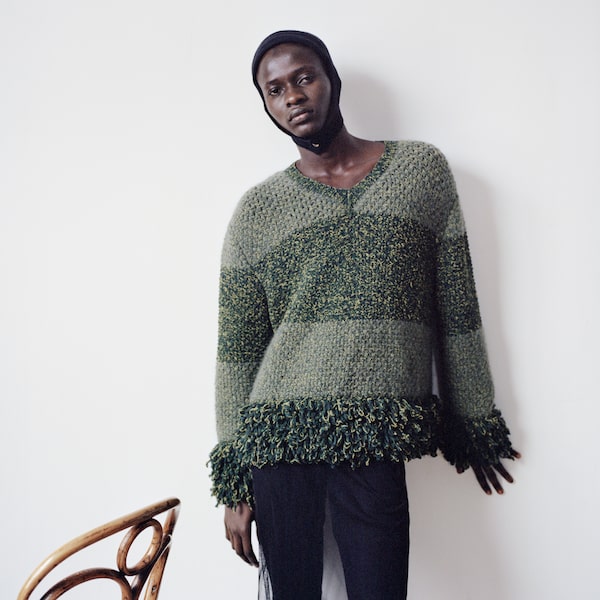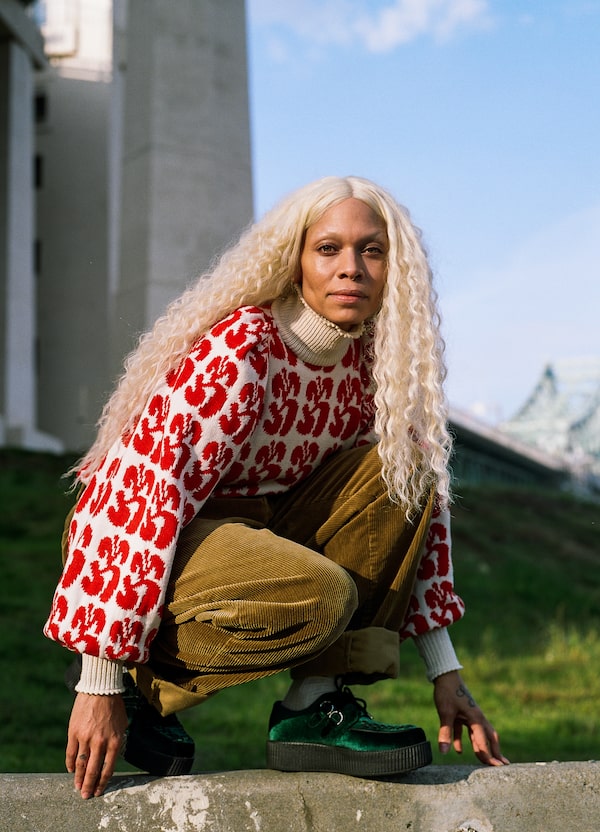Jessica Papp's pastime grew into Hotpot Variety, a line of hand-crocheted, primary-coloured checkered hats that is carried this season at Holt Renfrew.Handout
When Leah Legault launched her sweater line, Caulis, in the fall of 2018, she had already been doing her part to educate fellow Montrealers about the value of slow fashion. The designer had published two issues of her print magazine, Bienséance, which highlighted sustainable brands and demystified the process of ethical shopping. She was hosting events connecting the publication’s readers with local designers. Legault, who studied fibre arts in university, realized that she had also inadvertently been conducting market research for her future business – one that would prioritize craft and a sense of community. “I figured that I could probably do a knitwear brand,” she says.
Legault is part of a new wave of entrepreneurs ushering in a renaissance of handmade knitwear. They’re in good company in the fashion world. In designer collections this season, unique sweaters and knit accessories are one of the boldest trends. Labels such as Eckhaus Latta and Acne Studios are known for their arty, experimental knitwear, while New York-based Lauren Manoogian and Judy Turner create heirloom-level pieces carried by e-tailers such as Ssense and Trés Bien. The thread that connects these established fashion players to newer hobbyists-turned-designers is using the making process to rethink all the things that keep us cozy.

Judy Turner creates heirloom-level pieces carried by e-tailers such as Ssense and Trés Bien.Handout
In 2018, Taryn Fleischmann launched her Instagram account, @stringy__things. Her goal was to catalogue the embroidery that she was making for friends and selling in markets in Montreal. In 2019, she learned how to knit while watching YouTube tutorials and began knitting sweaters and sweater vests, but still had no intention of ever selling her designs. When the pandemic hit, she decided to start taking commissions and, as a result of the enthusiastic response, realized that she had developed a following for her work. Suddenly, she had a fledgling side hustle. “I do think that there was a huge shift to support local during the pandemic,” says Fleischmann, who also works in film animation and production.
For Fleischmann, Stringy Things is a way to be creative while connecting with those around her. When a “professional garbage picker” brought her some discarded yarn he found, she knit him a sweater vest and a matching hat. “I find when you’re small enough and have become immersed in the community enough, that there’s more room for collaboration,” she says. Fleischmann often finds herself experimenting, using bigger needles in place of smaller ones, or chunky yarn for a piece traditionally made with a finer gauge.
Emma Kenny, who works in events at the Vancouver Art Gallery, launched Not Hats, her line of crotched tuques and balaclavas, in February, 2020. “My friend was like, ‘Why don’t you just try and make 100 balaclavas – we could do an art show,’” Kenny says. “It really became such an awesome creative outlet.”

Leah Legault's sweater line, Caulis, which she launched in the fall of 2018.Kay Milz/Handout
Toronto’s Jessica Papp, who works in advertising, also learned how to knit and crochet through online videos, and started making a collection of bucket hats last October. “I got a lot of positive feedback through organic, social interactions with my friends online,” she says. “People [were] messaging me wanting to buy a hat or make them a hat. And because of all the positive responses that I got, it was really good timing where I felt like now is the time to launch a brand.” Papp’s pastime grew into Hotpot Variety, a line of hand-crocheted, primary-coloured checkered hats that is carried this season at Holt Renfrew.
As is often the case with smaller makers who need to balance the value of their time with a desire to make their wares as accessible as possible, cost can be the biggest challenge for these emerging designers. Fleischmann’s jumpers go for about $150. A Hotpot Variety hat is priced at $240 at Holt Renfrew. Legault aims to keep her prices below $200 to mostly cover materials – which can be steep, considering she tries to buy yarn locally from organic suppliers. The upside for shoppers is there’s great value in hand-knit pieces. “The price-point thing has been really tricky,” Legault says. “Especially when the [pieces] are very handmade on this old-school knitting machine. These sweaters normally would cost $500 upwards.”
Many of these designers are happy to break even if it allows them to continue to push the boundaries of what their needles can knit. “I do love to see this sort of breakthrough where knitting is actually getting the space that it deserves,” Fleischmann says. “It’s actually a very laborious process – it takes a lot of time and effort. Handmade knits from local makers are also easily accessible, she adds. “That’s why it’s been able to grow in this way.”
Sign up for The Globe’s arts and lifestyle newsletters for more news, columns and advice in your inbox.